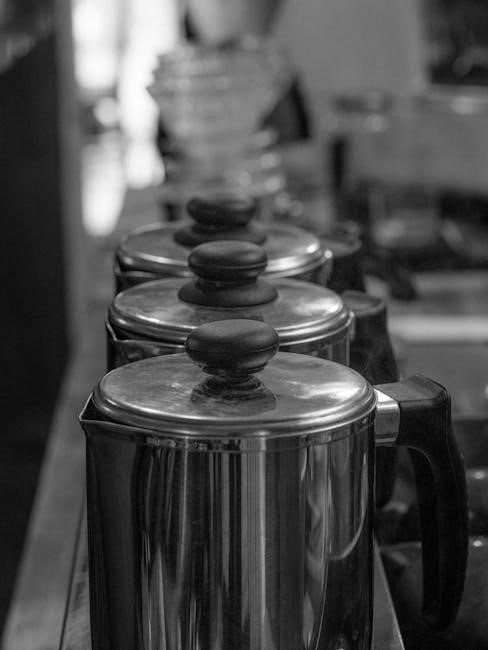Manual drip coffee is a clean, balanced brewing method offering full control over flavor, ideal for coffee enthusiasts seeking a gourmet experience with simplicity.
What is Manual Drip Coffee?
Manual drip coffee is a brewing method where hot water is poured over ground coffee beans, allowing the liquid to seep through a filter. This process produces a clean, balanced flavor with distinct notes. It involves manual control over water flow and coffee grounds, making it a popular choice for coffee enthusiasts. The method emphasizes simplicity and precision, offering a customizable brewing experience that highlights the coffee’s natural flavors. It’s often preferred for its clarity and the ability to tailor each cup to personal taste preferences.
Benefits of Manual Drip Brewing
Manual drip brewing offers a clean, balanced flavor with reduced acidity and bitterness. It provides full control over brewing parameters, allowing for a customizable experience. This method ensures a pure extraction of coffee oils, free from unwanted residues. It’s also portable, simple, and cost-effective, making it ideal for coffee lovers who value quality and precision. The ability to adjust coffee-to-water ratios and brewing times ensures a tailored cup every time, catering to individual preferences for strength and flavor.

Popular Manual Drip Brewing Methods
Popular methods include pour-over (V60, Chemex), hand drip (slow drip), and French Press, each offering unique flavor profiles and brewing experiences for coffee enthusiasts.
Pour-Over Method (V60, Chemex)
The pour-over method, including V60 and Chemex, involves manually pouring hot water over ground coffee beans in a filter. It offers a clean, bright, and nuanced cup with distinct flavor notes. The V60, designed by Hario, allows for a high degree of control over brewing parameters, while the Chemex, with its thick glass filter, ensures a smooth and balanced extraction. Both methods are popular among coffee enthusiasts for their simplicity, versatility, and ability to highlight the coffee’s natural characteristics.
Hand Drip (Slow Drip)
Hand drip, or slow drip, involves manually pouring hot water in a slow, circular motion over coffee grounds held in a filter. This method allows precise control over brewing, enabling a clean and balanced extraction. It results in a coffee that is less acidic and less bitter, with a smoother flavor profile. The process requires patience but offers a high degree of customization, making it a favorite among those who appreciate a meticulously crafted cup of coffee.
French Press vs. Manual Drip
French press and manual drip brewing differ significantly in process and results. French press involves steeping coarse coffee grounds in hot water, resulting in a bold, full-bodied coffee with a heavier texture. Manual drip, on the other hand, uses a filter to separate grounds from liquid, producing a cleaner, more nuanced flavor. While French press retains oils and sediment, manual drip offers a smoother, less bitter taste. The choice depends on the desired flavor profile and texture, with manual drip often preferred for its clarity and precision.
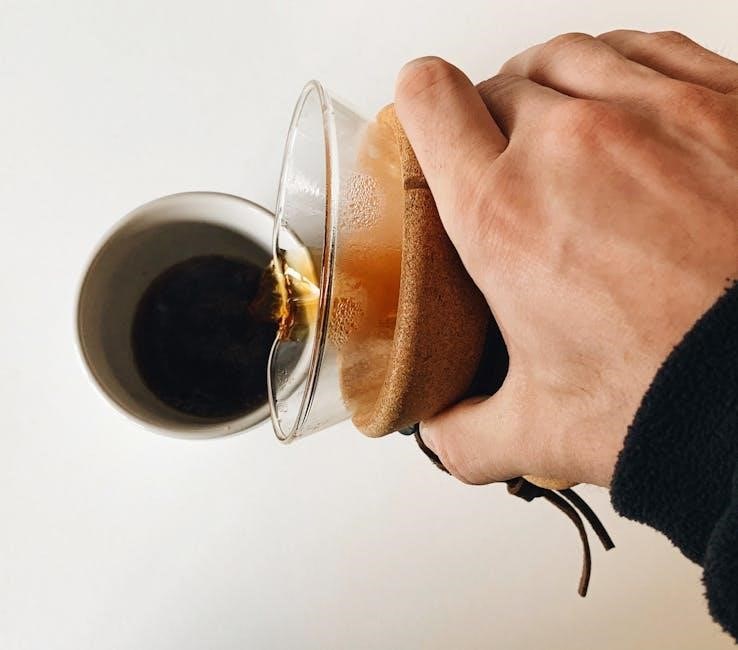
Tools and Equipment for Manual Drip
Essential tools for manual drip coffee include a dripper, filters, a grinder, and a gooseneck kettle. The Hario Skerton Pro is popular for grinding, while paper or metal filters affect flavor. Scales ensure precise measurements, and a coffee server helps serve perfectly brewed coffee, enhancing the overall brewing experience.
Coffee Grinders (Manual vs. Electric)
Coffee grinders are essential for manual drip brewing. Manual grinders, like the Hario Skerton Pro, offer precise control and are quieter, ideal for enthusiasts. Electric grinders are faster and more convenient, perfect for daily use. Manual grinders are affordable and portable, while electric models often feature adjustable settings. Both options ensure freshly ground beans, enhancing flavor. Manual grinders require effort but maintain aroma, while electric ones offer efficiency, making them a great choice for those seeking convenience without compromising quality.
Filters and Drippers (Paper vs. Metal)
Manual drip brewing relies on filters and drippers to shape the flavor. Paper filters absorb coffee oils, resulting in a cleaner, brighter taste, while metal drippers allow more oils to pass through, creating a bolder flavor. Paper filters are disposable and convenient, reducing cleanup, but metal drippers are reusable and eco-friendly. Metal drippers, like those with double mesh designs, prevent grounds from passing through, ensuring a smooth brew. The choice between paper and metal depends on desired flavor profile and convenience preferences.
Manual Drip Coffee Makers
Manual drip coffee makers, such as pour-over drippers and handheld devices, offer a portable and user-friendly brewing experience. Popular models include the V60, Chemex, and portable designs like the Drip Pod Youbi, ideal for outdoor use. These makers are crafted from materials like glass or stainless steel, balancing functionality with aesthetic appeal. They allow precise control over brewing parameters, making them favorites among coffee enthusiasts who value both flavor and convenience.
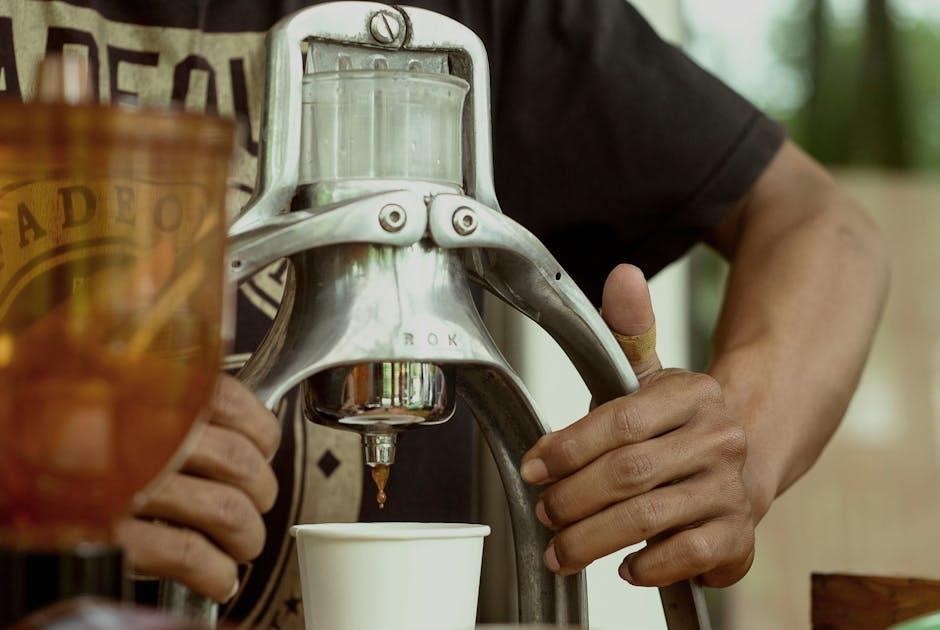
The Manual Drip Brewing Process
Manual drip brewing involves slowly pouring hot water over ground coffee in a filter, allowing it to drip through for a clean, balanced, and flavorful cup.
Step-by-Step Guide to Brewing
Start by preparing your equipment and rinsing the filter with hot water.
Measure and grind your coffee beans to the desired coarseness.
Place the filter in the dripper and add the grounds evenly.
Pour a small amount of water to bloom the coffee, then wait 30 seconds.
Gradually add the remaining water in a circular motion.
Allow the coffee to drip completely before serving.
This method ensures a clean, flavorful, and customizable cup of coffee.
The Importance of Water Temperature
Water temperature plays a crucial role in manual drip coffee, as it directly impacts extraction. Ideal temperatures range between 195°F and 205°F. If the water is too hot, it can burn the coffee, leading to bitterness. Conversely, water that’s too cool may result in under-extraction, yielding a weak or sour taste. Maintaining the correct temperature ensures balanced flavor and optimal extraction, making it a key factor in achieving a perfect cup of manual drip coffee.
Bloom and Extraction Phases
The bloom phase is the initial step in manual drip brewing, where a small amount of hot water is poured over the coffee grounds to release trapped gases and prepare the coffee for extraction. This crucial step ensures even saturation and prevents channeling. Following the bloom, the extraction phase begins as the remaining water is poured, allowing the coffee to drip through the filter. Proper extraction relies on factors like grind size and pouring technique, resulting in a balanced and flavorful cup of coffee.
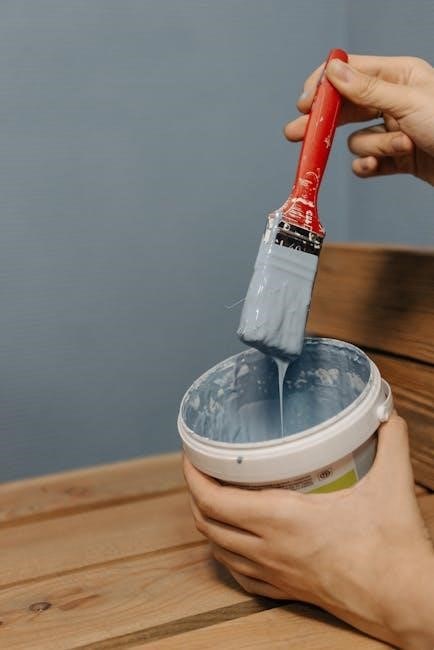
Coffee Grinding for Manual Drip
Coffee grinding is vital for manual drip, as it affects extraction and flavor. Manual grinders, like the Hario Skerton Pro, offer precise control, while electric grinders provide convenience.
Why Grinding Matters
Coffee grinding is crucial for manual drip as it directly impacts flavor and extraction. The grind size and distribution affect how water interacts with the beans. A burr grinder, whether manual or electric, ensures consistent particles, preventing under- or over-extraction. Freshly grinding beans preserves aromas and oils, enhancing the coffee’s quality. Proper grinding techniques allow for better control over the brewing process, ensuring a balanced and flavorful cup. It’s a foundational step that elevates the manual drip experience.
Best Grind Sizes for Manual Drip
The ideal grind size for manual drip coffee varies by method. For pour-over techniques like V60 or Chemex, a medium to medium-coarse grind is optimal, ensuring even extraction. A finer grind can lead to over-extraction and bitterness, while too coarse may result in under-extraction. Adjusting the grind size allows for personal preference in flavor profile. Consistent particles, achieved with a burr grinder, are key to balancing the brew. Experimenting with grind sizes helps tailor the coffee to your taste, enhancing the manual drip experience.
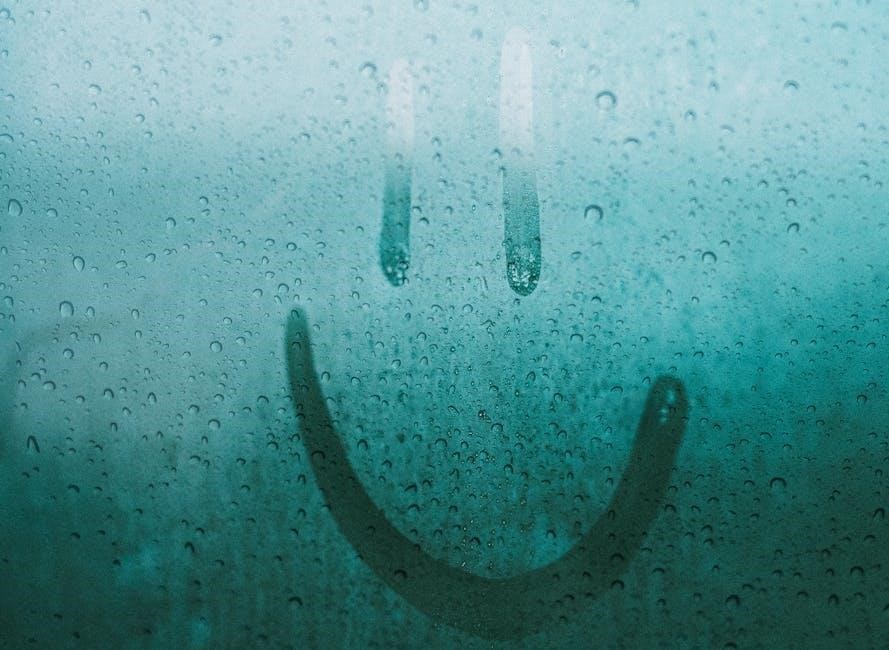
Water Quality and Manual Drip
Water quality significantly impacts the flavor of manual drip coffee. Using filtered water ensures a cleaner taste, while tap water may introduce impurities that alter the brew’s profile.
How Water Affects Flavor
Water quality significantly impacts the flavor in manual drip brewing. Impurities in tap water, such as minerals or chemicals, can introduce bitterness or unwanted tastes. Using fresh, filtered water ensures a cleaner extraction, preventing these impurities from altering the coffee’s natural profile. Hard water can over-extract, while soft water may under-extract, affecting balance. Pure water allows the coffee’s inherent flavors to shine, resulting in a more vibrant and balanced cup. This makes water quality a critical factor in achieving optimal flavor in manual drip coffee.
Using Filtered vs. Tap Water
Using filtered water in manual drip brewing ensures a cleaner and more consistent flavor, as it removes impurities and minerals that can alter taste. Tap water may contain chemicals or heavy minerals like calcium, which can cause scaling in equipment and introduce unwanted flavors. Filtered water prevents bitterness and ensures a smoother extraction. However, some prefer tap water for its mineral profile, which can enhance coffee’s natural flavors. Ultimately, filtered water is recommended for optimal results, while high-quality tap water can be a cost-effective alternative.
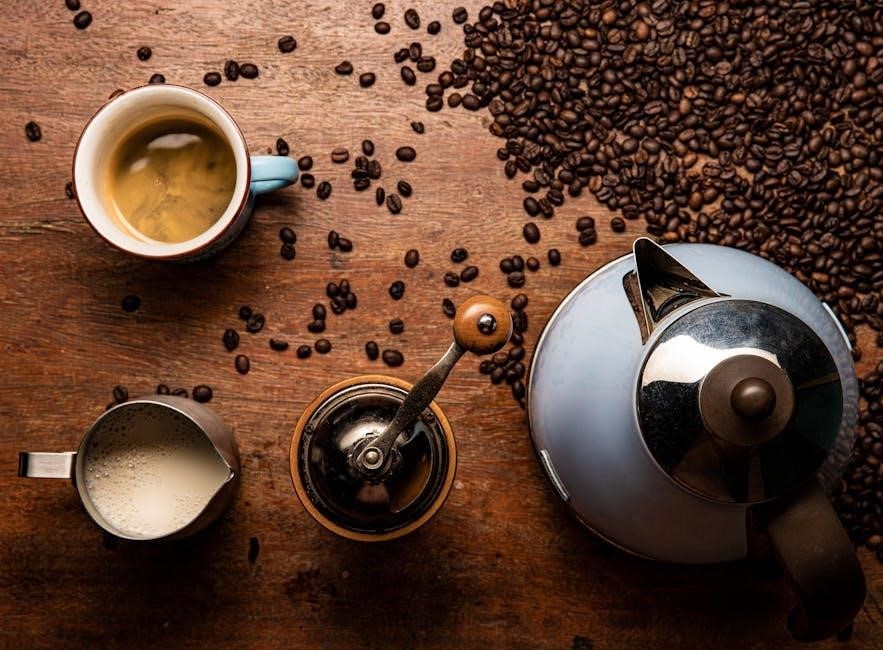
Manual Drip vs. Automatic Drip
Manual drip offers precise control and customizable brewing, while automatic drip provides convenience and speed, making it ideal for those seeking efficiency without compromising flavor quality.
Key Differences
Manual drip requires hands-on involvement, allowing for precise control over water temperature, flow, and coffee-to-water ratio, while automatic drip relies on a machine for automated brewing. Manual methods enable customization and nuanced flavor extraction, appealing to enthusiasts who value craftsmanship. Automatic drip prioritizes convenience, offering a quick and hands-off experience, making it ideal for busy households. The trade-off lies between personalization and efficiency, with manual drip delivering unique flavor profiles and automatic drip ensuring consistency and speed.
Pros and Cons of Each Method
Manual drip offers unparalleled control over brewing parameters, enabling unique flavor customization and a high-quality cup. However, it requires time, effort, and skill. Automatic drip is quick and convenient, ideal for busy routines, but sacrifices some control and may lack the nuanced flavors of manual methods. Manual drip is perfect for enthusiasts seeking a tailored experience, while automatic drip suits those prioritizing ease and speed without compromising on decent taste.
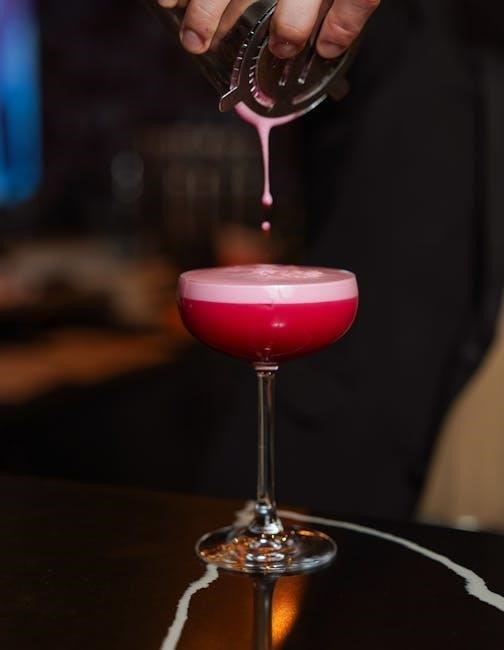
Health Benefits of Manual Drip Coffee
Manual drip coffee offers reduced acidity and bitterness, promoting easier digestion. It allows control over caffeine content and ensures fresh, high-quality beans for a healthier brew.
Reduced Acidity and Bitterness
Manual drip coffee often results in lower acidity and bitterness due to the controlled brewing process. The bloom phase and slow water flow prevent over-extraction, ensuring smoother flavors. This method also allows for precise adjustments in grind size and water temperature, further reducing harsh notes. The clarity and balance achieved through manual drip brewing make it ideal for those sensitive to acidic or bitter flavors, enhancing the overall drinking experience and showcasing the coffee’s natural profile more effectively.
Control Over Caffeine Content
Manual drip brewing offers precise control over caffeine content, allowing users to tailor their coffee to personal preferences. By adjusting the amount of coffee grounds, steeping time, and water temperature, one can achieve the desired caffeine levels. This method enables a balanced extraction, avoiding the over-extraction often seen in automatic brewers. It provides flexibility for those seeking a stronger or milder brew, making it ideal for both caffeine-sensitive individuals and those who prefer a bold cup, all while maintaining flavor quality and aroma.
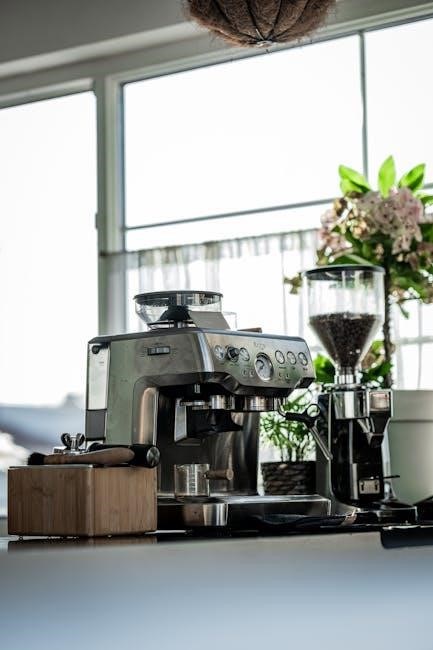
Common Mistakes in Manual Drip Brewing
Common mistakes include using incorrect water temperature, uneven coffee grounds, and improper pouring techniques, which can lead to under-extracted or bitter coffee, affecting overall flavor quality.
Incorrect Water Temperature
Incorrect water temperature is a common mistake in manual drip brewing. Water that’s too hot can burn the coffee, causing bitterness, while water that’s too cool may result in under-extraction. The ideal temperature for brewing is between 195°F and 205°F. Using water outside this range disrupts the extraction process, leading to a subpar cup of coffee. Monitoring and maintaining the correct temperature is crucial for achieving a balanced and flavorful brew. A thermometer can be a helpful tool to ensure accuracy.
Uneven Coffee Grounds
Uneven coffee grounds are a common mistake in manual drip brewing, leading to inconsistent extraction. Fine particles can over-extract, causing bitterness, while coarse parts under-extract, resulting in a weak taste. To avoid this, use a burr grinder for uniform grinding and avoid blade grinders. Ensure grounds are evenly distributed in the filter before brewing. This prevents channeling and ensures balanced flavor. Proper grinding and leveling are key to achieving optimal extraction and a delicious cup of manual drip coffee.

Tips for Mastering Manual Drip
Experiment with coffee-to-water ratios and grind sizes to refine flavor. Invest in quality tools and practice consistently for optimal results and a perfect brew every time.
Practice and Patience
Mastering manual drip coffee requires consistent practice and patience. Refine your technique by experimenting with ratios and timing. Over time, you’ll develop a deeper understanding of the process, leading to perfectly balanced brews. Patience is key, as each step—from pouring to waiting—plays a crucial role in flavor extraction. With dedication, you’ll unlock the full potential of manual drip brewing and enjoy a truly rewarding coffee experience.
Experimenting with Ratios
Experimenting with coffee-to-water ratios is key to perfecting manual drip brewing. Start with a standard 1:16 ratio and adjust to suit your taste preferences. A higher ratio yields weaker coffee, while a lower ratio results in a stronger brew. Documenting your experiments helps refine your technique. Pay attention to how small changes impact flavor balance and extraction. This process allows you to tailor each brew to your palate, making manual drip brewing a deeply personal and rewarding experience.
Manual drip coffee offers unparalleled control, flavor, and satisfaction, making it a rewarding method for coffee enthusiasts seeking a personalized and high-quality brewing experience.
Why Manual Drip is Worth the Effort
Manual drip coffee offers exceptional control over flavor, allowing for a personalized brewing experience. It reduces acidity and bitterness, delivering a cleaner, more balanced taste. The process, while requiring effort, is rewarding for enthusiasts seeking a high-quality cup. The ability to tailor every step, from grind size to water temperature, ensures a unique and satisfying result. For those passionate about coffee, the manual drip method is a worthwhile investment of time and skill.
